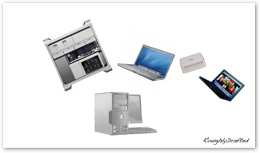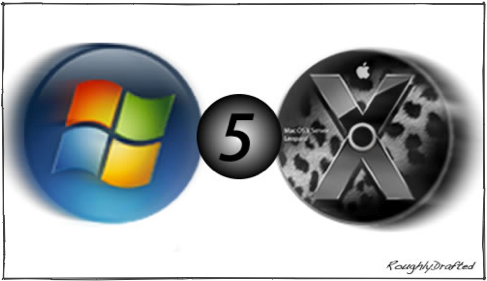
Leopard vs Vista 5: Development Challenges
Apple's Mac OS X Leopard and Microsoft's Vista follow different strategies in their prerelease marketing, product positioning, and market positioning, and integration. Here's how both differ in development issues.
The Difference of Development
One of the Notable Lessons presented in The Rise and Fall of Platforms is that the ideal way to develop popular software products is to ship early and often, making regular and progressive updates.
Microsoft successfully applied this strategy with both Office and Windows in order to build what are perhaps the two strongest brands in consumer software.
In the 90’s, Microsoft Windows made rapid advancement in the decade between version 3.0, the first release ever shipped pre-installed by a PC hardware maker and the first that could charitably be described as ‘serviceable,’ and version 5.1, also known as Windows XP.
Linux and other open source projects also illustrate the success behind shipping early and often, with many free and open source projects offering new software builds on a daily basis.
Similarly, Google, Yahoo's Flickr, and other popular Web 2.0 services also attract users by progressively offering regular updates and new features.
When Development Stalls
While Apple has recently delivered frequent updates to Mac OS X and its growing software portfolio, the company's past experiences demonstrate the devastating consequences of slipping behind and failing to deliver on announced technology plans.
The Rise of Windows described how Apple dropped the ball in its efforts to maintain forward momentum in Mac development in the early 90's, just as Microsoft Windows was gaining traction in the market as an alternative. The result was catastrophic for Apple, and left Microsoft with little competition on the desktop.
Apple fell behind largely because the company's leadership did little to set a progressive pace and steer a clear direction for the future. Like a ship without a rudder or sails, Apple could only slowly float in the direction that past momentum has pushed it.
That was not good enough maintain the lead, because Microsoft was not only rowing frantically, but had a clear sense of direction on how to develop markets, attack competitors, and steal their booty.
Deus ex Machina!
After six years of protracted failure in attempting to deliver a substantial update to 1991's rapidly aging Mac System 7, NeXT suddenly appeared as a guardian angel to magically swoop down, fill Apple’s sails with a infusion of new technology, and decisively set bold new directions for the company. 

How CPR Saved Apple described how NeXT cast Apple's underperforming dead weight overboard, and replaced its monolithic and proprietary technology plans with more modern and open components.
Leveraging existing, proven code from external open source projects allowed Apple to move faster and more efficiently. Once up to speed, the new Apple charted a strategic course in new software development described in Why Apple Bounced Back, and worked develop an effective retail strategy.
The Shadow Stalker
In an almost spooky series of events, Microsoft has shadowed Apple’s brush with death, making the exact same set of moves exactly ten years after Apple:
-
•From 1995 to 2001, Microsoft rapidly delivered advancements to its desktop Windows product ...just as Apple rapidly advanced the Mac System Software from 1985-1991.
-
•In 2001, Microsoft began announcing technologies that would be released as part of Longhorn and later Blackcomb ...just as Apple described new technologies intended for Copland and Gershwin a decade prior.
-
•From 2002-2006, Microsoft dropped features, changed plans, and started over several times in protracted efforts to ship Longhorn ...just as Apple had fumbled around with Copland ten years earlier.
-
•By 2006, it was obvious that Microsoft's Longhorn was not going to live up to the hype, and would really be just a refresh of the existing Windows XP ...just as Copland had been gutted in 1996 and its salvaged remains delivered as the optimistically named Mac OS 8.
-
•Microsoft outed Blackcomb as vaporware ...just as Apple admitted that Gershwin had never been anything but a list of deferred goals ten years earlier.
What’s Next?
The only difference between Apple and Microsoft is that today, in the final days of 2006, there is no equivalent to a 1996 NeXT waiting in the wings to swoop down and fix Microsoft's mess.
The company promises not to fall prey to letting its development slip for half a decade again, but offers no credible suggestion of how they plan to prevent that from happening. Microsoft obviously wasn't planning to sit around for five years without delivering anything back in 2001.
Baring an incubated technology company jumping out of the woodwork to save the day, Microsoft offers little explanation of how the company's dead weight will be thrown overboard, how its snoozy old technology bathing in legacy will be outfitted by modern new ideas, and how its ongoing, headline grabbing security flaws and architectural deficiencies will be elegantly fixed.
The only way this metaphor could continue to play out would be if Linux assumed control of the PC this winter, kicked Microsoft's old guard to the curb, and began preparing for the day when Windows is dramatically placed in a casket and all new development work is based on POSIX. According to my calculations (I just add ten), that should happen in 2012.
The Copland Syndrome
As Mac users and developers from a decade ago remember, the half decade of transition from Mac OS 7.6 to Mac OS X was bumpy and fraught with uncertainty.
Even after NeXT got things back on track for Apple, the company suffered through a difficult period before it was obvious that the new Apple had a clear direction, full sails, and a competent crew.
In 2002, Apple began to catch up with Windows XP when it delivered Mac OS X Jaguar. A year later Apple shipped Panther, and a year and a half after that it shipped Tiger. Meanwhile, Microsoft continued to revise its plans, drop features, and announce delays to the ship date for Longhorn, now called Vista.
That, in itself, is another difference that complicates comparing Leopard to Vista: Leopard is just the latest release of the continuously evolving Mac OS X, while Vista represents a monolithic chunk of a half decade of unreleased development.
Totally Quarked
That also puts Microsoft at an early disadvantage: short of time travel, there's no way Microsoft can match Apple's five years of shipped development work. It is simply impossible to deliver any large and complex product without any issues, and as the size and complexity increase, so do the bugs and vulnerabilities.
Vista has some serious complications that hinder its ability to make up for lost time. Last year’s Is Microsoft’s Vista the Next Quark XPress? compared Microsoft with Quark:

Like Quark, Microsoft is facing new competition. Also like Quark, Microsoft is seriously underestimating the danger it faces in fumbling the ball just as that competition is in place for an interception.
Real Artists Ship
The size of Microsoft's development resources don't help, but instead actually complicates product management. To get Vista in the hands of real users for hands on testing, Microsoft initiated a long public beta designed to work out as many bugs as possible. During this time, ongoing development work continued and significant product changes were made; major features of Vista were dropped or postponed.
In contrast, Apple has been releasing its ongoing work into actual production at regular intervals since 2001. Apple's annual release schedule was so aggressive that developers asked the company to extend the period between releases. Leopard marks the longest period between major Mac OS X releases ever: nearly two years.
Throughout the last half decade, Mac OS X has been in constant actual real world use by millions of users. Apple has a delivered a proven track record for shipping planned features on time, and following up with regular updates and security patches.
Leveraging Open Source
A significant part of Apple's ability to ship comes from its partnerships with open source developers. That allows Apple to incorporate proven, high quality code as well as regular core OS technology advancements and refinements while concentrating on delivering a polished interface and usability.
Rather than tracking the code of outside projects, Microsoft maintains its own code. This isolationism not only prevents Microsoft from adopting outside advances in technology, but also means that fewer people see the code and have the opportunity to point out problems or contribute fixes.
This gives Apple another advantage with Leopard over Vista: Leopard isn't a huge new ball of wax representing a half decade of code development that has only seen beta testing, but rather the latest evolution and refinement of Tiger, a product that already compares favorably with Microsoft's soon to be released Vista.
The Difference of the Challenges Faced
Apple's existing Mac OS X Tiger has been in ongoing use by millions of grandmas, creative professionals, school kids, and molecular biologists for nearly two years. 

Leopard doesn't face a huge list of security flaws, legacy baggage, and core architectural problems that desperately need to be fixed; its just icing on a cake that already tastes pretty good.
Vista, on the other hand, faces significant challenges. Microsoft's existing Windows XP is the root of the most expensive destruction caused by any operating system ever.
Severely FUBAR
Windows deficiencies have spawned a third party market for antivirus and security tools that drains away many billions of dollars of direct repair costs, and untold billions of lost productivity every year.
Vista is challenged with solving poor engineering decisions made in past decades: some were the product of earlier technology limitations, but others were the result of sloppy and irresponsible development, a fact that even Microsoft publicly recognizes.
In addition to the problems Microsoft has created, the company also struggles with problems caused by bad third party development for which the company has no control. Developers who skirted Microsoft's public APIs and refuse to let go of deprecated legacy have forced the company to support a mess of old technology that impedes progress and folds excessive complexity into Microsoft's code base.
Out of Control
If Microsoft were entirely in control of its own destiny, it could quickly banish support for legacy hardware and decisively move developers into the future by laying out clean new APIs and simply killing off the outdated, arcane ways of doing things that drag down Windows development like millions of tiny anchors tearing up the ocean floor as the ship from Redmond struggles to push forward.
As a smaller, nimbler company that isn’t hamstrung by foot dragging hardware partners, Apple can plot its own future, and has solved its legacy issues by enforcing the meaning of deprecated.
Apple isn't escaping a plague of viruses and spyware because of its smaller installed base, but rather because of the simpler, cleaner design of its software, a luxury afforded by the company's power to move decisively and cast off the unnecessary baggage and boat anchors of past legacy.
This gives Apple another advantage with Leopard over Vista: Leopard can quickly adopt and exploit new features though its tight integration with a known, limited set of hardware precisely because it only runs on Apple's Macs.
Microsoft's Vista not only has to support an incredible variety of existing hardware, but is also obligated to support a lot of poorly written software as well. 

This has worked in Microsoft's favor in the past, as its legacy support served to complicate rivals’ efforts to compete against Windows in the PC operating system market. Against Apple however, it puts Microsoft at a significant disadvantage, particularly in the consumer markets Apple is targeting.
Legacy development issues also play into the technology that shapes the elegance Leopard and Vista can offer.
Next Article: Leopard vs Vista 6: Technology
This Series










Sunday, November 19, 2006



 Bookmark on Del.icio.us
Bookmark on Del.icio.us Discuss on Reddit
Discuss on Reddit Critically review on NewsTrust
Critically review on NewsTrust Forward to Friends
Forward to Friends
 Get RSS Feed
Get RSS Feed Download RSS Widget
Download RSS Widget





